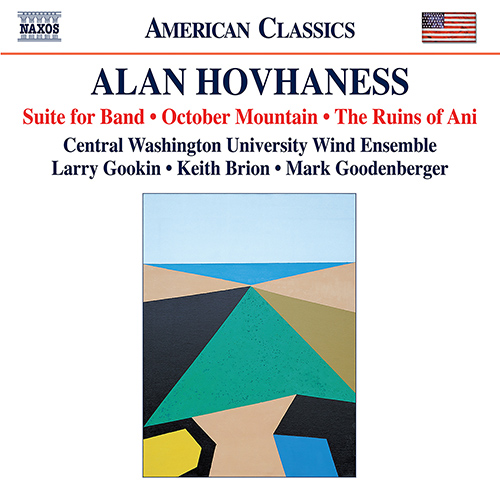…The performances are all first-rate and show off the considerable skills of the members of Central Washington University Wind Ensemble and its conductors Keith Brion, Mark Goodenberger, and Larry Gookin. Consequently, recommended. © 2019 Fanfare Read complete review
The opener sets the tone, both soaring and homely, evocative of close-knit American communities, putting the listener in a favourable mood for what follows.
Mountain Under the Sea is next. It is inspired by the idea that are there are thousands of mountains under the sea that we never see; the overall tone is exotic, far eastern (think Japan), a saxophone delivering ethereal music over the sound of pelagic bangs and bubbles. © 2018 Review Corner Read complete review
I’m impressed by a number of skillful soloists in Three Improvisations on Folk Tunes (1952), where Indian and Pakistani styles are heard. Flutist Maggie Whiteman and harpist Adrienne Shields are a fine duo in ‘Vision on a Starry Night’ (1985); eventually they are joined by xylophonist Taylor Edwards. © 2018 American Record Guide Read complete review on American Record Guide
The most lustrous gems in this musical jewel box are works for band. Hovhaness exulted in solemn, incantatory brass and woodwind melismas, spotlighted in the Armenian processional Tapor No.1, Three Improvisations on Folk Tunes (from India and Pakistan), Hymn to Yerevan and the six-movement Suite for Band. © 2018 The WholeNote Read complete review
The wind ensemble encompasses angry buzzing then coaxing yet pallid melancholy—a sense of gentle and healing floats clear. Predominantly introspective, The Burning House overture is memorable for softly ‘stung’ gongs resonating alongside Maggie Whiteman’s very quiet flute. We end with the little six-movement Suite for Band: with three Arias interspersed among two Processionals and a Canzona. The six are played with minimal breaks. © 2018 MusicWeb International

…it is not the ensemble that really attracts here but the repertoire that has put the album on British classical charts. A few pieces here have gained exposure: October Mountain is a fixture of percussion ensemble concerts in the U.S., at least, but several are world premieres. This is all to the good, for the broader the picture of Hovhaness that emerges, the more remarkable his output as a whole seems in its diversity. © 2018 AllMusic.com Read complete review
The music gets capable and careful treatment in the hands (and lips and teeth) of the Central Washington University Wind Ensemble and selected soloists. The music ranges in time (1948–1985) and instrumentation (from full wind band to solo flute and much in between). © 2018 Gapplegate Classical-Modern Music Review Read complete review
Naxos have become a champion of music by Alan Hovhaness, and here collect together ten pieces for wind instruments including four World Premiere Recordings. They were composed over almost forty years of his long life, the earliest—the Tapor No.1, for Processional for Band—dating from 1948, looking back to the Baroque era, those influences then mixed with his Armenian parentage in creating the six short pieces used in the Suite for Band. Taking the disc in chronological order, three years later he completed October Mountain for a percussion sextet, the five relatively quiet movements using tuned instruments with gongs and bass drum. Moving forward one more year for the Three Improvisations on Folk Tunes, Hovhaness evokes areas of the Indian subcontinent—Bansri, Bengal and Pakistan—but couched in a Western musical culture. His deluge of scores included a one-act chamber opera, The Burning House, written under Japanese influences, the extended overture scored for flute and percussion quartet. Seven more years and we reach the 1969 Hymn to Yerevan, a work for wind band with religious connotations, Yerevan being the region when in strife Armenians fled for refuge. In their culture Ani is important as the place where war and suffering lasted intermittently for seven hundred years until that capital city no longer existed. Here we have for that city a 1972 lament for the ‘City of a Thousand Churches’ played by eight clarinets in a purely tonal idiom. Taking his theme from the known mass of mountains under the sea, his score, Mountain Under the Sea, has an otherworldly atmosphere that also links to the Vision on a Starry Night from the following year, 1985. With the date of composition unknown, the remaining track is a Meditation on Ardalus for solo flute. I commend the disc to you, but it is a ‘bits and pieces’ release, and a work of lengthy substance would have made a welcome change. The young people of the Central Washington University Wind Ensemble are convincing advocates. © 2018 David’s Review Corner
These short band pieces (none longer than nine minutes) range from the earliest band piece, the processional Tapor No. 1 of 1948 to more recent chamber pieces such as the gentle barcarole of Vision on a Starry Night (1985). The Ruins of Ani returns us to the tragic location also explored in Hovhaness’ Symphony No. 23 “Ani”, while the Improvisations evoke dances from the Indian subcontinent. Newly discovered works with percussion include the Japanese-influenced overture to the opera The Burning House (1962) alongside October Mountain (1942/1951) now a classic in its genre. © 2018 Records International

































